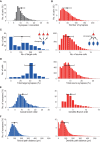The neocortical microcircuit collaboration portal: a resource for rat somatosensory cortex
- PMID: 26500503
- PMCID: PMC4597797
- DOI: 10.3389/fncir.2015.00044
The neocortical microcircuit collaboration portal: a resource for rat somatosensory cortex
Keywords: experimental data; ion channels; microcircuit; models; morphologies; neocortex; neurons; synapses.
Figures









References
Publication types
MeSH terms
LinkOut - more resources
Full Text Sources
Other Literature Sources
Molecular Biology Databases

